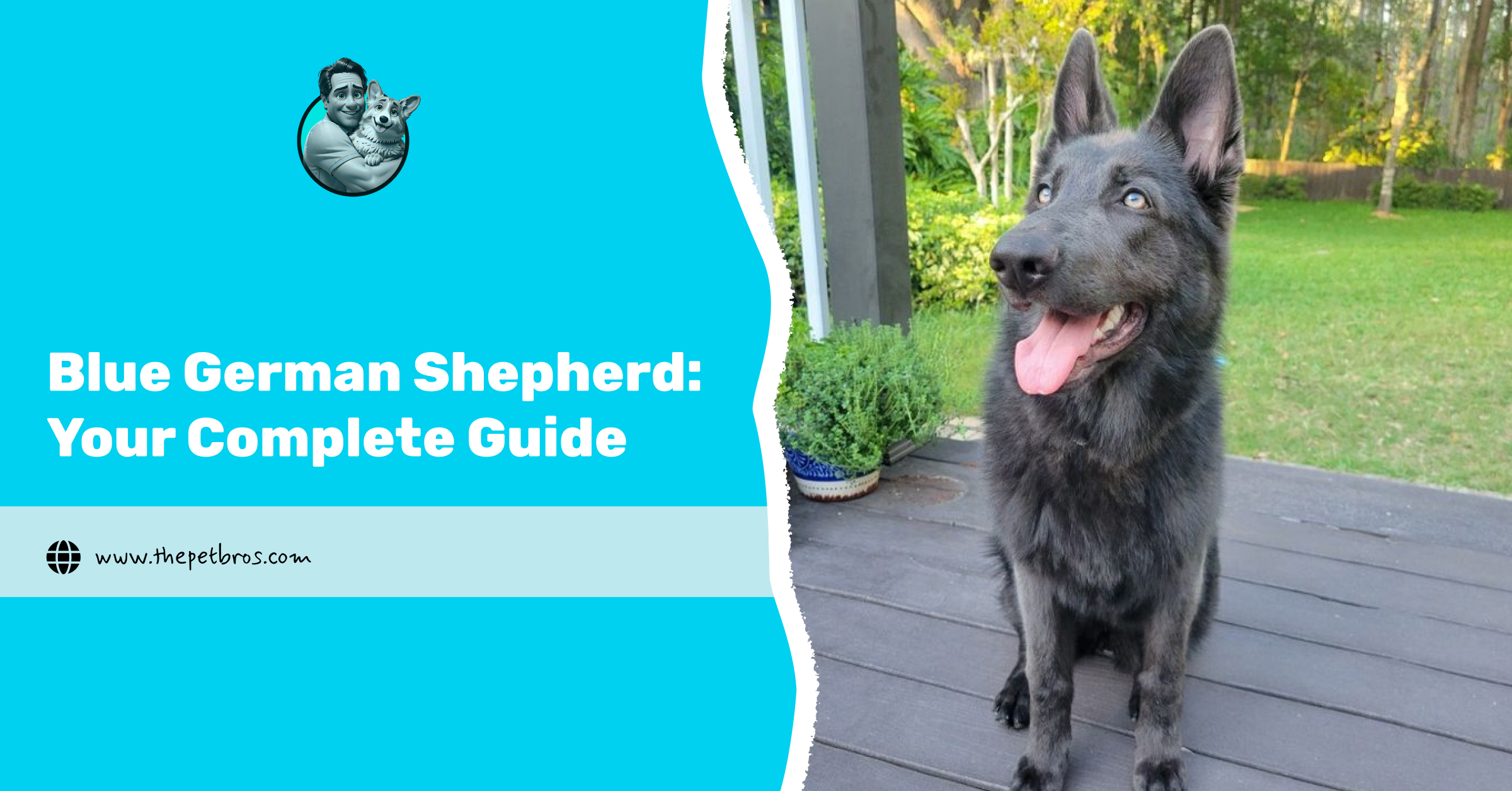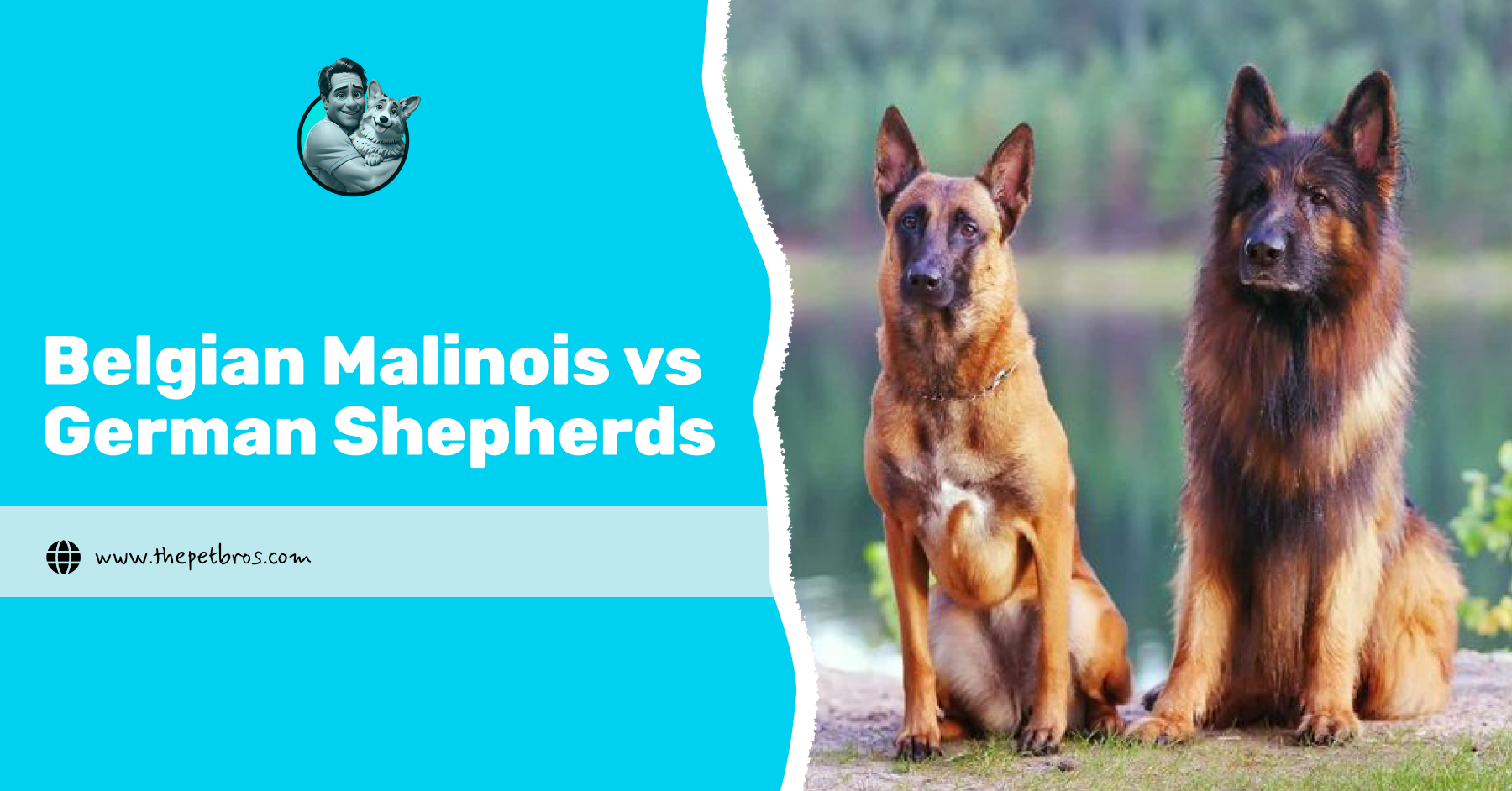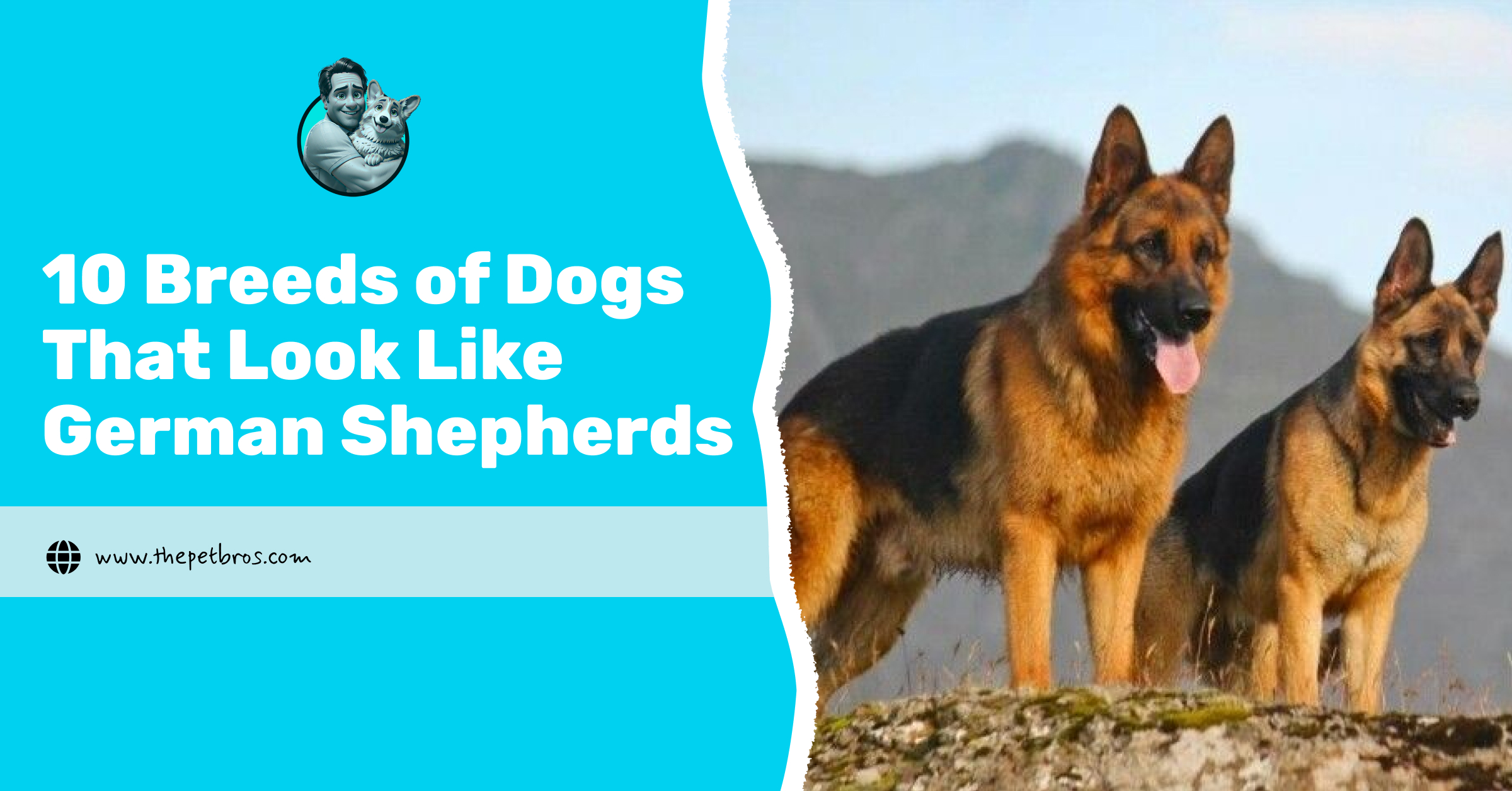When you first hear someone say blue German Shepherd, you probably picture a dog that glows in the dark or was dipped in paint, but it’s neither. This rare breed gets its steel-blue coat from a simple dilution gene, and not a trip to the art supplies aisle, as you may have thought.
At first glance, a blue German Shepherd looks like your regular German Shepherd dressed in a sleek new outfit. Same confident stance, same intelligent eyes, same “I’m smarter than you” vibe. But that unique blue-grey coat is what makes heads turn at the dog park.
Here’s the thing, despite all the online debates about whether they’re “real,” the blue German Shepherd is every bit as loyal, trainable, and protective. The only real difference is the colour, and maybe the fact that your neighbours won’t stop asking about it. In this article, we will discuss everything there is to know about blue German shepherds.
The History and Genetics of the Blue German Shepherd

Of course, the blue German Shepherd didn’t fall out of the sky or come from a secret superhero lab. Its history goes way back to the early 1900s in Germany, when Captain Max von Stephanitz first developed the German Shepherd breed. Among the many puppies bred for intelligence and working ability, a few carried something special in their DNA, which is a recessive dilution gene known as dd.
Here’s one of those fun German Shepherd facts that surprises most people: this gene doesn’t change the dog’s personality at all, but it does work a little magic on colour. It lightens the black pigment (eumelanin) in the coat, eyes, and nose, turning it into a cool shade of steel blue or soft gray. Basically, it’s nature’s version of a filter, one that can’t be turned off.
The first recorded German Shepherd, Horand von Grafrath, even had blue offspring, proving that this colour variation has been around for over a century. Despite what many people think, major kennel clubs like the American Kennel Club (AKC) do recognise the blue German Shepherd as a purebred dog. The catch is that the blue coat is listed as a “serious fault” in show standards, meaning they can’t compete in conformation events. Still, they’re fully eligible for registration, training, and other competitions, which seems fair enough for a dog this stunning.
Still, many dog lovers and parents don’t care about the paperwork. They see the blue German Shepherd for what it truly is: a loyal, hardworking, intelligent dog that just happens to come with a very cool paint job.
Appearance, Health, Life Span, and Physical Traits
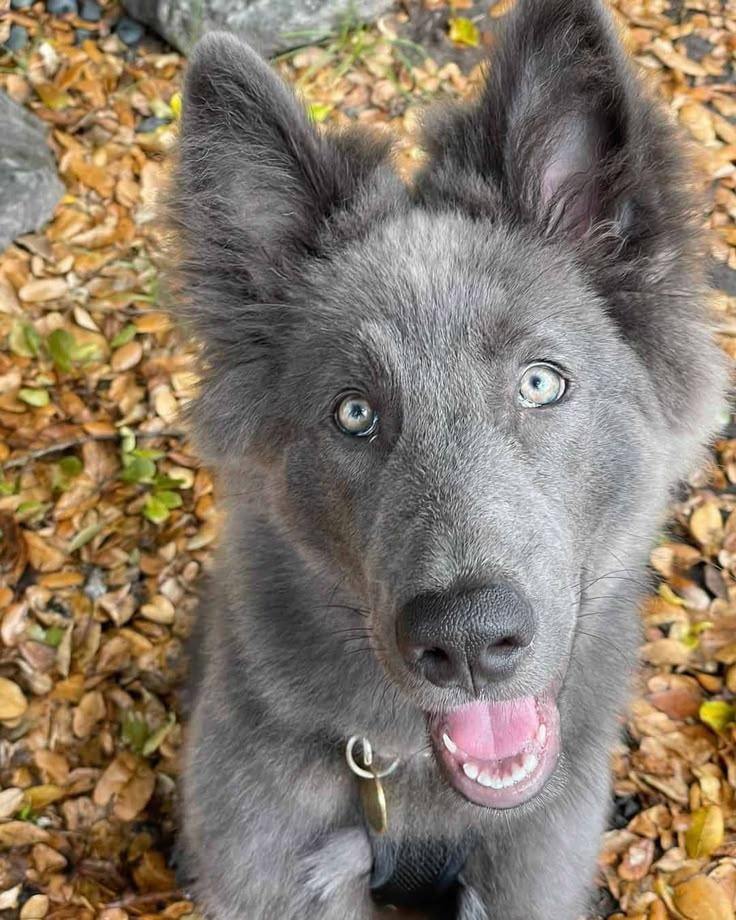
If the blue German Shepherd had a dating profile, its bio would probably read: “Same loyal heart, just a cooler coat.” Everything about this dog screams German Shepherd except for that unique steel-blue shade that steals the spotlight. And while there are breeds that resemble German Shepherds, such as the Belgian Malinois or the King Shepherd, none quite capture that calm confidence and silver-steel shine like this one.
| Trait | Details |
|---|---|
| Coat Colours | Steel blue, powder blue, blue silver, blue and tan, or blue panda |
| Size | Males: 65–90 lbs / Females: 50–70 lbs |
| Eye Colour | Light brown, amber, or pale yellow |
| Build | Muscular, medium to large, with erect ears and a confident stance |
| Health | Prone to hip dysplasia, bloat, and joint issues, similar to all German Shepherd Dogs |
| Lifespan | 9–13 years on average |
| Grooming Needs | 2–4 brushes per week; heavier during shedding seasons |
Are Blue German Shepherds Real? Myths vs Facts
Somewhere along the way, the blue German Shepherd became the internet’s favourite “is-it-real” debate. The truth is, it’s not some designer mix or photo edit; it’s a genuine German Shepherd with a unique gene that softens the black coat into that striking steel-blue shade. Myths have been circulating about it for years. Let’s clear up the confusion once and for all.
Myth 1: Blue German Shepherds are a separate breed.
Fact: Nope. They’re the same loyal, hardworking German Shepherds everyone knows, just rocking a unique steel-blue coat. Think of it like your classic Shepherd in designer clothing.
Myth 2: The blue coat changes their temperament.
Fact: That’s like saying your hoodie changes your personality. The blue gene only affects colour, not character. These dogs are still intelligent, trainable, and protective, all the reasons people love German Shepherds in the first place.
Myth 3: Blue German Shepherds are unhealthy.
Fact: Not true. Their health risks are the same as any other GSD; hip dysplasia, bloat, and joint issues are common across the breed. The only rare concern is colour dilution alopecia, a skin condition linked to the same gene that gives them their colour, and even that’s uncommon.
Myth 4: Blue German Shepherds aren’t purebred.
Fact: Many purebred GSDs can carry the dilution gene; it’s been part of the breed’s DNA since the early 1900s. Registered breeders can easily trace lineage to prove authenticity.
In short, blue German Shepherds are just as real, loyal, and brilliant as their classic black-and-tan counterparts; they’ve just got that “rare limited edition” vibe.
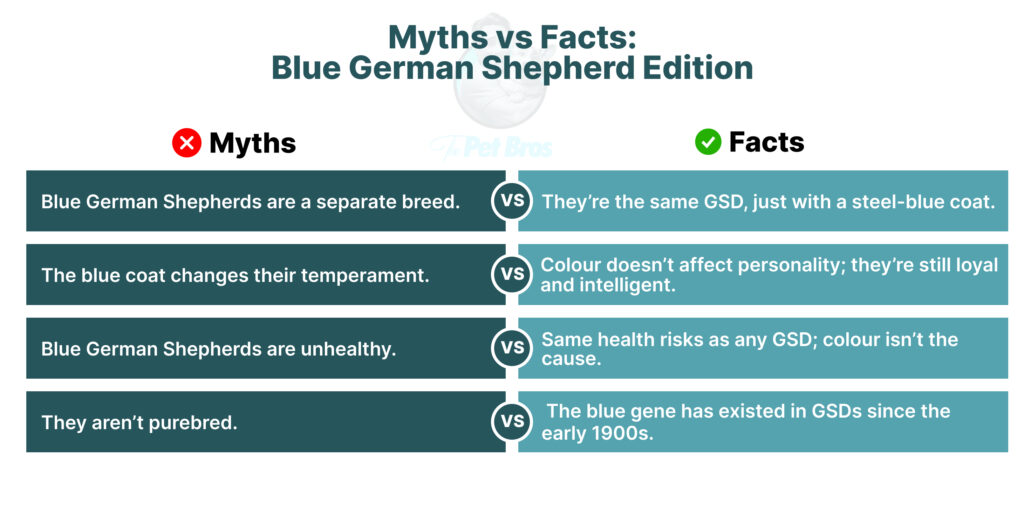
Pros and Cons of Owning a Blue German Shepherd
Owning a blue German Shepherd is like owning a luxury car, stunning to look at, full of power, and guaranteed to turn heads everywhere you go. However, like any high-performance machine, it requires some maintenance.
Pros of Owning a Blue Shepherd
- Show-stopping looks: That rare steel-blue coat makes them total attention magnets.
- Loyal to the bone: Once they bond with you, they’re your shadow for life.
- Brains and beauty: Sharp, obedient, and quick learners, training them feels like a team effort.
- Protective instincts: Naturally alert and reliable family guardians.
- Active lifestyle buddy: They thrive on long walks, runs, and any excuse to get moving.
Cons of Owning a Blue Shepherd
- Rare means pricey: Their unique colour can make them expensive to buy.
- Energy overload: Without enough exercise, expect boredom-fuelled chaos (and creative digging).
- Heavy shedders: Blue coat or not, your vacuum will become your new best friend.
- Attention seekers: They hate being left alone for too long. Separation anxiety is common among shepherds, except you’ve got yourself a dog that hates socialising.
- Potential for colour dilution alopecia: Rare, but worth considering for coat health.
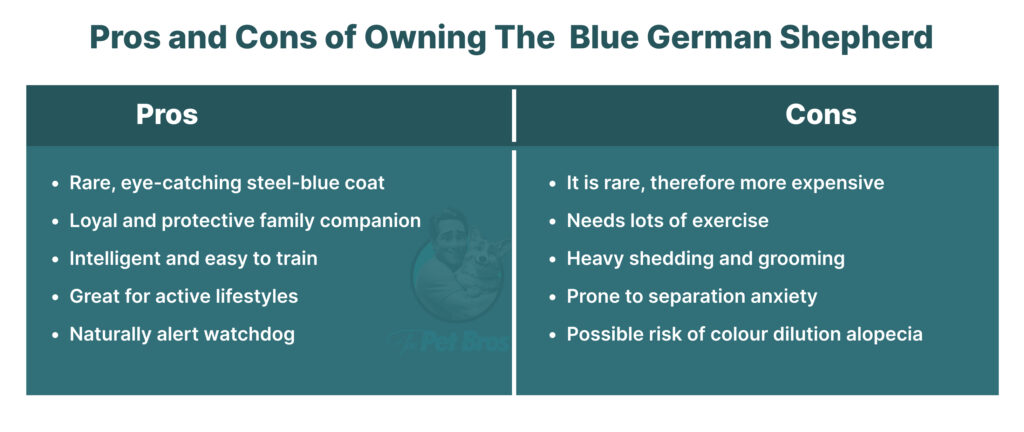
Grooming, Exercise, and Training Needs
Blue German shepherds are built like athletes, and they expect you to keep up. Grooming, playtime, and training are all part of the package.
1. Grooming
The blue German Shepherd may look sleek, but its double coat tells a different story. Expect fur on your clothes, on your sofa, maybe even in your morning tea. Brush them 2–4 times a week, and increase to twice that frequency during shedding season. Regular grooming keeps their coat shiny and reduces the dreaded hair tumbleweeds floating around the house.
2. Exercise
They’re not called working dogs for nothing. These pups require at least 60–90 minutes of daily activity, such as walks, runs, fetch, or agility games. Without it, they’ll invent their own “fun,” which usually involves redecorating your backyard.
3. Training
Blue German Shepherds are intelligent, sometimes to the point of being overly intelligent. They learn quickly but also get bored easily. Keep sessions short, positive, and varied. Now, here’s something worth noting: not every dog is a social butterfly. Some dogs just hate socialising, and that’s okay. But early and gentle socialisation helps your blue German Shepherd dog grow into a confident, well-rounded dog.
4. Nutrition Tip
Feed them a balanced, protein-rich diet; their bodies are built for performance. Avoid overfeeding (no matter how convincing those puppy eyes are) to prevent joint problems down the line.
Blue German Shepherd vs Standard German Shepherd
| Feature | Standard German Shepherd | Blue German Shepherd |
|---|---|---|
| Coat Colours | Typically black and tan, sable, or bi-colour | Steel-blue, blue-silver, or blue-tan (caused by the dilution gene) |
| Recognition | Fully recognised by major kennel clubs (AKC, UKC, etc.) | Considered a “fault” in AKC standards but accepted elsewhere |
| Temperament | Loyal, protective, intelligent, family-oriented | The same loyal and protective nature colour doesn’t affect behaviour |
| Energy Level | Very high thrives on activity and structure | Equally high energy, often slightly calmer in temperament |
| Rarity | Common and widely available | Rare, due to a recessive dilution gene |
| Price Range | Moderate, depending on pedigree | Higher rarity often increases demand |
| Shedding & Grooming | Heavy shedding year-round | Same level of shedding and grooming needs |
| Popularity | Among the top dog breeds globally | Growing in popularity for its unique look |
Should You Get a Blue German Shepherd?
If you want a loyal, intelligent dog with a one-of-a-kind look, the blue German Shepherd won’t disappoint. They’re active, protective, and full of heart, but they need time, training, and plenty of exercise. If you can keep up, you’ll have a stunning companion that’s as devoted as they come. But if you think this breed might be more than you can chew, you can also check out the White German Shepherd or the Black Coloured German Shepherd.
Blue German Shepherd FAQs
What is the rarest German Shepherd colour?
Colours like liver, panda, and isabella are considered rarer than blue.
How big do blue German Shepherds get?
Males reach 65–90 lbs, females 50–70 lbs, similar to standard GSDs.
How to spot a fake German Shepherd puppy?
Check pedigree, health certificates, and avoid unusually low prices.
How to know a purebred German Shepherd?
Look for official registration, consistent physical traits, and reputable breeders.
What dog looks like a German Shepherd but isn’t?
Breeds like the Belgian Malinois, King Shepherd, or Shiloh Shepherd often get mistaken for German Shepherds.






